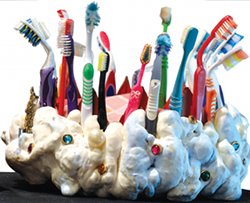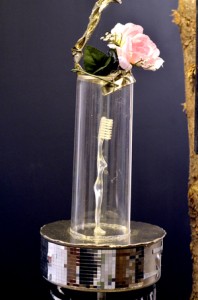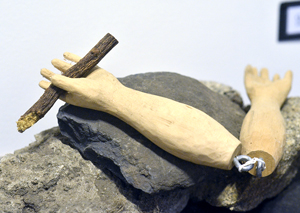

copyright the Chronicle June 25, 2014
by Joseph Gresser
GLOVER — The word “everyday” means usual or common. It might seem, then, that the Museum of Everyday Life would be a humdrum collection of boring objects. The selection of themes covered in the museum’s four-year history — matches, safety pins, pencils, and, now, toothbrushes — might do nothing to change that view.
A visit to the museum, though, quickly upends any such preconception. Curator Clare Dolan has filled an old dairy barn with a collection of exhibits that uses dental hygiene alone as a lens through which to view the world.
Starting with the tooth stick, — a twig, often of licorice, which people chewed to keep their teeth clean — Ms. Dolan leads the viewer through the history of the toothbrush, from the hog bristle brushes developed by the Chinese, through the modern version fitted with nylon bristles.
Along the way there are numerous digressions. For instance, in discussing the history of nylon, Ms. Dolan tells the sad story of DuPont chemist Wallace Carothers, who discovered the fiber in 1935 and, two years later, took his own life in despair over his lack of accomplishment.
Mr. Carothers killed himself by drinking a solution containing cyanide, illustrated in the museum by an uncorked glass pitcher and a shot glass lying on its side.

The museum’s exhibits are both informative and witty. A toothbrush disguised as a lipstick tube is shown next to a classic black handbag. A brush with a handle in the shape of a woman’s leg is shown against the backdrop of a black lace negligee.
These examples are only some of the many remarkable brushes on display. For some reason, novelty brushes have long been popular items, and the museum has a wide variety.
Among the choicest items is the Mickey Mouse toothbrush, with its bristles set in the back of the famous rodent’s head. The brush encourages children to clean their teeth to a tune that plays when Mickey’s nose is pressed.
The brush is displayed in its original package, which is designed to allow shoppers to try the musical feature before they buy. According to its label the young user should keep brushing as long as the music keeps playing.
Ms. Dolan observes the forms of museum decorum, carefully crediting the collectors of loaned items. One of these is a toothbrush with a clear handle in the shape of a nude woman, displayed in a clear tube, topped by an artificial rose. The exhibit includes a photograph of its owner, Ron Kelley, and a careful account of the provenance of the item — a fancy museum word for the history of the brush.
“This toothbrush was found by Ron Kelley, in 1985, when he moved into an apartment at 520 E. 11th St. NYC. Several years later Ron left the city for southern Vermont,” the label reads. “During the spring of 1990, his wife discovered the toothbrush lolling about on his desk. It surprised her. A lively conversation ensued. Since that conversation this toothbrush was removed from Ron’s desk and brought down to the tool section in their basement where it languished for 24 years until it was resurrected for this exhibit.”

Some other friends of Ms. Dolan’s contributed items to the exhibit, including replicas of “shanks,” which are knives made by prison inmates by sharpening toothbrush handles or by mounting razor blades into toothbrushes. One incarcerated pal helped out by sending the correction system’s answer to the shank, a toothbrush without a full-length handle.
The inmate can brush his teeth by holding onto a piece that looks like the head of a key, attached to the business end of the brush.
Visitors have the opportunity to interact with some of the exhibits, including a toothbrush crown listed as being part of Maryann Colella’s spring 2014 collection.
This glorious item, ringed with a colorful assortment of brushes, is displayed on a wardrobe table. Visitors to the museum are encouraged to photograph themselves wearing the crown. Ms. Dolan herself declined to model the crown for posterity.
The Museum of Everyday Life has as its motto, “Embarking on a Mission of Glorious Obscurity,” but that irony is undercut by Ms. Dolan’s sharp curatorial vision.
What could be just a collection of cute and curious items is somehow melded into a clear picture of the world we live in. A side note on how the daily ritual of brushing teeth was made universal by soldiers returning from World War II, casts a light on the unexpected effects war has on our lives.

Similarly, an odd brush that incorporates a gear in its handle to automate the process of cleaning one’s teeth, suggests the desire for people to ease the least burdensome of tasks.
Ms. Dolan, a visual and performance artist, has an expansive and kind view of the world, one that should be experienced as widely as possible. Her uncommonly interesting museum, which is open every day, can be found about five miles south of Glover Village on Route 16. Just look for the giant toothbrush out front.
contact Joseph Gresser at [email protected]
For more free articles from the Chronicle like this one, see our Reviews pages. For all the Chronicle’s stories, pick up a print copy or subscribe, either for print or digital editions.







